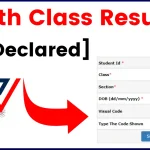Mathematics for Class 8 under the West Bengal Board of Secondary Education (WBBSE) includes a variety of topics designed to build a solid foundation for higher studies.
All following are class 8 math solution for wbbse
Chapter 1: Rational Numbers
Understanding Rational Numbers
Rational numbers are numbers that can be written as a fraction, where both the top number (numerator) and the bottom number (denominator) are whole numbers. The denominator should not be zero. For example, 3/4 is a rational number.
Example Problem and Solution
Problem: Simplify the rational number 48/64.
Solution:
- Find the Greatest Common Divisor (GCD): The first step is to find the largest number that can divide both 48 and 64 without leaving a remainder. For this, we find the common factors of both numbers. The common factors of 48 and 64 include 1, 2, 4, 8, and 16. The largest common factor is 16.
- Divide the Numerator and Denominator by the GCD: Next, we divide both the numerator and the denominator by 16.
- 48 divided by 16 is 3.
- 64 divided by 16 is 4.
Therefore, 48/64 simplifies to 3/4.
Chapter 2: Linear Equations in One Variable
Understanding Linear Equations
A linear equation in one variable is an equation that involves only one variable and can be written in a simple form. For example, x + 5 = 10 is a linear equation where x is the variable.
Example Problem and Solution
Problem: Solve the equation x + 7 = 12.
Solution:
- Isolate the Variable: To solve for x, we need to get x alone on one side of the equation. We do this by performing the same operation on both sides of the equation. Here, we subtract 7 from both sides.
- x + 7 – 7 = 12 – 7
- Simplify: Simplifying both sides, we get:
- x = 5
So, the solution to the equation x + 7 = 12 is x = 5.
Chapter 3: Understanding Quadrilaterals
Types of Quadrilaterals
Quadrilaterals are four-sided figures. There are various types of quadrilaterals, including squares, rectangles, parallelograms, rhombuses, and trapezoids. Each type has its own properties.
Example Problem and Solution
Problem: Find the perimeter of a rectangle with length 8 cm and width 5 cm.
Solution:
- Understand the Perimeter: The perimeter of a rectangle is the total distance around the edge of the rectangle. It is calculated by adding the lengths of all four sides.
- A rectangle has two lengths and two widths.
- Perimeter = 2 * (Length + Width)
- Calculate: Here, the length is 8 cm and the width is 5 cm.
- Perimeter = 2 * (8 + 5)
- Perimeter = 2 * 13
- Perimeter = 26 cm
So, the perimeter of the rectangle is 26 cm.
Chapter 4: Practical Geometry
Drawing Geometric Shapes
Practical geometry involves drawing shapes accurately using tools like a ruler and compass. It includes constructing angles, triangles, and other polygons.
Example Problem and Solution
Problem: Draw a triangle with sides 5 cm, 6 cm, and 7 cm.
Solution:
- Draw the Base: Using a ruler, draw a straight line 7 cm long. This will be the base of the triangle.
- Construct the First Side: From one end of the base, use a compass to draw an arc with a radius of 5 cm.
- Construct the Second Side: From the other end of the base, use the compass to draw another arc with a radius of 6 cm. The point where these two arcs intersect is the third vertex of the triangle.
- Complete the Triangle: Connect the vertex to both ends of the base using a ruler.
Now you have a triangle with sides 5 cm, 6 cm, and 7 cm.
Chapter 5: Data Handling
Organizing Data
Data handling involves collecting, organizing, and interpreting data. This can include creating bar graphs, pie charts, and line graphs.
Example Problem and Solution
Problem: Represent the following data in a bar graph: Number of students in different classes – Class 6: 40, Class 7: 35, Class 8: 50, Class 9: 45.
Solution:
- Draw the Axes: Draw a horizontal axis (x-axis) and a vertical axis (y-axis). Label the x-axis with the classes and the y-axis with the number of students.
- Mark the Data: On the x-axis, mark the classes (Class 6, Class 7, Class 8, Class 9). On the y-axis, mark a scale that includes the highest number of students (50 in this case).
- Draw the Bars: For each class, draw a bar that reaches up to the corresponding number of students:
- Class 6: Draw a bar up to 40.
- Class 7: Draw a bar up to 35.
- Class 8: Draw a bar up to 50.
- Class 9: Draw a bar up to 45.
Chapter 6: Squares and Square Roots
Understanding Squares and Square Roots
A square of a number is that number multiplied by itself. The square root of a number is a value that, when multiplied by itself, gives the original number.
Example Problem and Solution
Problem: Find the square root of 81.
Solution:
- Identify the Square Root: Think of a number that, when multiplied by itself, equals 81.
- The number 9 multiplied by itself (9 x 9) equals 81.
So, the square root of 81 is 9.
Chapter 7: Cubes and Cube Roots
Understanding Cubes and Cube Roots
A cube of a number is that number multiplied by itself twice. The cube root of a number is a value that, when used in three multiplications, gives the original number.
Example Problem and Solution
Problem: Find the cube root of 27.
Solution:
- Identify the Cube Root: Think of a number that, when multiplied by itself twice, equals 27.
- The number 3 multiplied by itself twice (3 x 3 x 3) equals 27.
So, the cube root of 27 is 3.
Chapter 8: Comparing Quantities
Understanding Ratios and Percentages
Comparing quantities often involves using ratios and percentages. A ratio compares two quantities, while a percentage represents a part of a whole as parts per hundred.
Example Problem and Solution
Problem: Find the ratio of 20 to 50 and express it as a percentage.
Solution:
- Find the Ratio: To find the ratio, divide both numbers by their greatest common divisor. The greatest common divisor of 20 and 50 is 10.
- Ratio: 20 divided by 10 is 2, and 50 divided by 10 is 5.
- So, the ratio is 2:5.
- Convert to Percentage: To convert the ratio to a percentage, think of it as a fraction and multiply by 100.
- Ratio as a fraction: 2 out of 5 is 2/5.
- Convert to percentage: (2/5) multiplied by 100 is 40%.
So, the ratio 2:5 is equivalent to 40%.
Chapter 9: Algebraic Expressions and Identities
Understanding Algebraic Expressions
Algebraic expressions are combinations of numbers, variables, and operations. For example, 3x + 2 is an algebraic expression.
Example Problem and Solution
Problem: Simplify the expression 2x + 3x – x.
Solution:
- Combine Like Terms: To simplify, combine all terms that have the same variable (x in this case).
- 2x + 3x – x: Combine 2x and 3x to get 5x, then subtract x.
So, the simplified expression is 4x.
Chapter 10: Visualizing Solid Shapes
Understanding Solid Shapes
Solid shapes include 3D objects like cubes, cylinders, spheres, and cones. These shapes have length, width, and height.
Example Problem and Solution
Problem: Identify the shape with 6 equal faces.
Solution:
- Identify the Shape: A shape with 6 equal faces is known as a cube. Each face of the cube is a square, and all faces are the same size.
So, the shape with 6 equal faces is a cube.
Chapter 11: Mensuration
Understanding Mensuration
Mensuration involves calculating the area, perimeter, and volume of different shapes. Area is the amount of space inside a shape, perimeter is the distance around a shape, and volume is the space a 3D shape occupies.
Example Problem and Solution
Problem: Find the area of a rectangle with length 10 cm and width 5 cm.
Solution:
- Calculate the Area: To find the area, multiply the length by the width.
- Area: 10 cm multiplied by 5 cm equals 50 square cm.
So, the area of the rectangle is 50 square cm.
Chapter 12: Exponents and Powers
Understanding Exponents
Exponents are a way to express repeated multiplication of the same number. For example, 2 to the power of 3 (written as 2^3) means 2 multiplied by itself 3 times.
Example Problem and Solution
Problem: Simplify the expression 2^3.
Solution:
- Calculate the Power: 2 to the power of 3 means 2 multiplied by itself 3 times.
- 2 x 2 x 2 equals 8.
So, 2^3 simplifies to 8.
Chapter 13: Direct and Inverse Proportions
Understanding Proportions
Proportions compare two ratios. In direct proportion, as one quantity increases, the other also increases. In inverse proportion, as one quantity increases, the other decreases.
Example Problem and Solution
Problem: If 5 pens cost 25 rupees, how much will 8 pens cost?
Solution:
- Find the Cost of One Pen: First, find the cost of one pen by dividing the total cost by the number of pens.
- Cost of one pen: 25 rupees divided by 5 pens equals 5 rupees per pen.
- Calculate the Cost of 8 Pens: Multiply the cost of one pen by 8.
- 8 pens: 5 rupees per pen multiplied by 8 equals 40 rupees.
So, 8 pens will cost 40 rupees.
Chapter 14: Factorization
Understanding Factorization
Factorization involves breaking down a number or an expression into its factors. Factors are numbers or expressions that multiply together to get the original number or expression.
Example Problem and Solution
Problem: Factorize the number 24.
Solution:
- Find the Factors: To factorize 24, find the numbers that multiply together to give 24.
- Factors of 24 include 1, 2, 3, 4, 6, 8, 12, and 24.
So, the factors of 24 are 1, 2, 3, 4, 6, 8, 12, and 24.
Chapter 15: Introduction to Graphs
Understanding Graphs
Graphs are visual representations of data. Common types include bar graphs, line graphs, and pie charts.
Example Problem and Solution
Problem: Plot a line graph for the following data: Day 1: 5 books sold, Day 2: 7 books sold, Day 3: 9 books sold, Day 4: 6 books sold.
Solution:
- Draw the Axes: Draw a horizontal axis (x-axis) for the days and a vertical axis (y-axis) for the number of books sold.
- Mark the Data Points: On Day 1, mark a point at 5 books sold on the y-axis. On Day 2, mark a point at 7 books sold, and so on.
- Connect the Points: Draw a line connecting all the points from Day 1 to Day 4.
Now you have a line graph representing the number of books sold over 4 days.
Chapter 16: Playing with Numbers
Understanding Patterns
Playing with numbers involves recognizing patterns and using them to solve problems. This includes identifying number sequences and understanding their rules.
Example Problem and Solution
Problem: What is the next number in the sequence 2, 4, 6, 8, 10?
Solution:
- Identify the Pattern: The sequence increases by 2 each time.
- Find the Next Number: Add 2 to the last number in the sequence (10).
- 10 + 2 equals 12.
So, the next number in the sequence is 12.
Chapter 17: Probability
Understanding Probability
Probability is the chance of an event happening. It is expressed as a number between 0 and 1, where 0 means the event will not happen, and 1 means it will definitely happen.
Example Problem and Solution
Problem: What is the probability of flipping a coin and getting heads?
Solution:
- Identify Possible Outcomes: When flipping a coin, there are two possible outcomes: heads or tails.
- Determine the Probability: Since there are two outcomes and only one is heads, the probability of getting heads is 1 out of 2.
So, the probability of flipping a coin and getting heads is 1/2 or 0.5.
Chapter 18: Understanding Quadratic Equations
Understanding Quadratic Equations
A quadratic equation is an equation that involves the square of a variable. For example, x^2 + 5x + 6 = 0 is a quadratic equation.
Example Problem and Solution
Problem: Solve the quadratic equation x^2 – 4 = 0.
Solution:
- Isolate the Square Term: Add 4 to both sides to isolate the square term.
- x^2 = 4
- Find the Square Roots: The values of x that satisfy this equation are the numbers whose square is 4.
- The numbers are 2 and -2.
So, the solutions to the quadratic equation x^2 – 4 = 0 are x = 2 and x = -2.
Chapter 19: Introduction to Trigonometry
Understanding Trigonometry
Trigonometry deals with the relationships between the sides and angles of triangles. It is especially useful for right-angled triangles.
Example Problem and Solution
Problem: In a right-angled triangle, if one angle is 30 degrees and the hypotenuse is 10 cm, find the length of the side opposite the 30-degree angle.
Solution:
- Use Trigonometric Ratios: In a right-angled triangle, the side opposite a 30-degree angle is half the hypotenuse.
- Half of 10 cm is 5 cm.
So, the length of the side opposite the 30-degree angle is 5 cm.
By understanding and practicing these example problems and solutions, Class 8 students can build a strong foundation in mathematics. Regular practice and review of these concepts will help students excel in their exams and prepare for higher-level math in the future.
Latest Posts
- Step-by-step guide to download and apply for jee mains admit card 202
- Comprehensive 2025 government holidays and recruitment details for job seekers
- JEE Mains Admit Card 2025: Your Step-by-Step Guide to Downloading the Hall Ticket
- Everything You Need to Know About 2025 Government Holidays Recruitment
- Comprehensive Guide to rrb d group recruitment 2025 – Eligibility, Vacancies, and Application
- Detailed guide to nps trust recruitment 2025 vacancies, eligibility and apply process
- Comprehensive guide to hpcl recruitment 2025 notification, vacancies, and application process
- ignou bed admission 2025 complete recruitment guide with eligibility and process
- Comprehensive Guide to Indian Army Agniveer Recruitment 2025 Notification and Jobs
- Everything You Must Know About CBSE Board Exams 2025 Changes & New Rules





